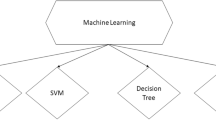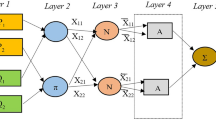Abstract
In this paper, the strength of basalt fiber reinforced concrete (BFRC) was investigated. Four percentages of basalt fiber (0.1%, 0.2%, 0.3%, and 0.4%) by volume fraction were added to concrete mix and BFRC cubes of 150 mm size were prepared and tested after 28 days curing age. It was found that the compressive strength of concrete with basalt fibers (1–4 percent) decreased in the range of 9.71–18.62 percent for M25. To predict the compressive strength of BFRC, three soft computing techniques, i.e., Random Forest (RF), Stochastic Random Tree, Artificial Neural Network (ANN) were applied for Nine inputs, i.e., Cement, Fine Aggregate, Coarse Aggregate, Water, Fly Ash, Superplasticizer, BF, length of Fiber, curing time, and which is Compressive Strength as output. The results showed correlation coefficient (CC) were (0.9938, 0.9755), (0.9985, 0.9342), and (0.9793, 0.7308) in training and testing stages, respectively, for RF, Stochastic RT and ANN. The Stochastic Random Tree was the outperforming model among the three applied ones. The sensitivity analysis showed that curing period is the most critical input in compressive strength.


















Similar content being viewed by others
Data availability
Enquiries about data availability should be directed to the authors.
References
Abu Arqub O (2017) Adaptation of reproducing kernel algorithm for solving fuzzy Fredholm-Volterra integrodifferential equations. Neural Comput Appl 28:1591–1610
Abu Arqub O, Singh J, Maayah B, & Alhodaly M (2021a) Reproducing kernel approach for numerical solutions of fuzzy fractional initial value problems under the Mittag–Leffler kernel differential operator. Mathemat Methods Appl Sci. https://doi.org/10.1002/mma.7305
Abu Arqub O, Singh J, & Alhodaly M (2021b) Adaptation of kernel functions‐based approach with Atangana–Baleanu–Caputo distributed order derivative for solutions of fuzzy fractional Volterra and Fredholm integrodifferential equations. Mathemat Method Appl Sci. https://doi.org/10.1002/mma.7228
Adesina A (2021) Performance of cementitious composites reinforced with chopped basalt fibres–an overview. Construct Build Mater 266:120970. https://doi.org/10.1016/j.conbuildmat.2020.120970
Alshammari M, Al-Smadi M, Arqub OA, Hashim I, Alias MA (2020) Residual series representation algorithm for solving fuzzy duffing oscillator equations. Symmetry 12(4):572
Altunkaynak A, Özger M, Şen Z (2005) Regional streamflow estimation by standard regional dependence function approach. J Hydraul Eng 131(11):1001–1006
Arslan ME (2016) Effects of basalt and glass chopped fibers addition on fracture energy and mechanical properties of ordinary concrete: CMOD measurement. Constr Build Mater 114:383–391. https://doi.org/10.1016/j.conbuildmat.2016.03.176
Ayub T, Shafiq N, Nuruddin MF (2014) Effect of chopped basalt fibers on the mechanical properties and microstructure of high performance fiber reinforced concrete. Adv Mater Sci Eng 2014:587686. https://doi.org/10.1155/2014/587686
Banibayat P, Patnaik A (2014) Variability of mechanical properties of basalt fiber reinforced polymer bars manufactured by wet-layup method. Mater Des 1980–2015(56):898–906. https://doi.org/10.1016/j.matdes.2013.11.081
Breiman L (1999) Using adaptive bagging to debias regressions (p 16). Technical report 547, Statistics Department UCB
Breiman L (2001) Random forests. Mach Learn 45:5–32
Buckley JJ, Hayashi Y (1994) Fuzzy neural networks: a survey. Fuzzy Sets Syst 66(1):1–13
Can I (2002) A new improved Na/K geothermometer by artificial neural networks. Geothermics 31(6):751–760
Deepa C, SathiyaKumari K, Sudha VP (2010) Prediction of the compressive strength of high performance concrete mix using tree based modeling. Int J Comput Appl 6(5):18–24
Demirel MC, Venancio A, Kahya E (2009) Flow forecast by SWAT model and ANN in Pracana basin. Portugal Adv Eng Software 40(7):467–473
Fiore VINCENZO, Di Bella G, Valenza A (2011) Glass–basalt/epoxy hybrid composites for marine applications. Mater Des 32(4):2091–2099. https://doi.org/10.1016/j.matdes.2010.11.043
Fu Q, Niu D, Zhang J, Huang D, Hong M (2018) Impact response of concrete reinforced with hybrid basalt-polypropylene fibers. Powder Technol 326:411–424
Gamal TSF, Chiadighikaobi PC (2019) Comparative analysis of reliability of non-destructive methods of strength control of concrete impregnated with vegetable oil: basalt fiber for increasing the concrete strength. Mater Today: Proc 19:2479–2482
Hsu KL, Gupta HV, Sorooshian S (1995) Artificial neural network modeling of the rainfall-runoff process. Water Resour Res 31(10):2517–2530
Ibrahim D (2016) An overview of soft computing. Procedia Comput Sci 102:34–38
Jalal M (2015) Soft computing techniques for compressive strength prediction of concrete cylinders strengthened by CFRP composites. Sci Eng Compos Mater 22(1):97–112
Jalasutram S, Sahoo DR, Matsagar V (2017) Experimental investigation of the mechanical properties of basalt fiber-reinforced concrete. Struct Concr 18(2):292–302. https://doi.org/10.1002/suco.201500216
Jang JSR, Sun CT, Mizutani E (1997) Neuro-fuzzy and soft computing-a computational approach to learning and machine intelligence. IEEE Trans Autom Control 42(10):1482–1484
Jiang C, Fan K, Wu F, Chen D (2014) Experimental study on the mechanical properties and microstructure of chopped basalt fibre reinforced concrete. Mater Des 58:187–193. https://doi.org/10.1016/j.matdes.2014.01.056
Jun W, Ye Z (2010) Experimental research on mechanical and working properties of non-dipping chopped basalt fiber reinforced concrete. In: 2010 3rd International Conference on Information Management, Innovation Management and Industrial Engineering, Vol. 4. IEEE, pp 635–637. https://doi.org/10.1109/ICIII.2010.633
Katkhuda H, Shatarat N (2017) Improving the mechanical properties of recycled concrete aggregate using chopped basalt fibers and acid treatment. Constr Build Mater 140:328–335. https://doi.org/10.1016/j.conbuildmat.2017.02.128
Kirthika SK, Singh SK (2018) Experimental investigations on basalt fibrereinforced concrete. J Inst Eng (India): Ser A 99:661–670. https://doi.org/10.1007/s40030-018-0325-4
Kisi Ö (2004) Multi-layer perceptrons with Levenberg-Marquardt training algorithm for suspended sediment concentration prediction and estimation/Prévision et estimation de la concentration en matières en suspension avec des perceptrons multi-couches et l’algorithme d’apprentissage de Levenberg-Marquardt. Hydrol Sci J 49(6):2004
Kişi Ö (2008) River flow forecasting and estimation using different artificial neural network techniques. Hydrol Res 39(1):27–40
Kizilkanat AB, Kabay N, Akyüncü V, Chowdhury S, Akça AH (2015) Mechanical properties and fracture behavior of basalt and glass fiber reinforced concrete: an experimental study. Constr Build Mater 100:218–224
Militky J, Kovaˇciˇc V, Rubnerová J (2002) Influence of thermal treatment on tensile failure of basalt fibers. Eng Fract Mech 69:1025–1033
Mohammadyan-Yasouj SE, Ghaderi A (2020) Experimental investigation of waste glass powder, basalt fibre, and carbon nanotube on the mechanical properties of concrete. Constr Build Mater 252:119115
Mohammed A, Rafiq S, Sihag P, Kurda R, Mahmood W (2020) Soft computing techniques: systematic multiscale models to predict the compressive strength of HVFA concrete based on mix proportions and curing times. J Build Eng 33:101851
Niu D, Su L, Luo Y, Huang D, Luo D (2020) Experimental study on mechanical properties and durability of basalt fiber reinforced coral aggregate concrete. Constr Build Mater 237:117628. https://doi.org/10.1016/j.conbuildmat.2019.117628
Pulido-Calvo I, Portela MM (2007) Application of neural approaches to one-step daily flow forecasting in Portuguese watersheds. J Hydrol 332(1–2):1–15
Silverman D, Dracup JA (2000) Artificial neural networks and long-range precipitation prediction in California. J Appl Meteorol 39(1):57–66
Sim J, Park C (2005) Characteristics of basalt fiber as a strengthening material for concrete structures. Compos B Eng. https://doi.org/10.1016/j.compositesb.2005.02.002
Singh B, Sihag P, Tomar A, SEHGAL, A. (2019) Estimation of compressive strength of high-strength concrete by random forest and M5P model tree approaches. J Mater Eng Struct 6(4):583–592
Sun X, Gao Z, Cao P, Zhou C (2019) Mechanical properties tests and multiscale numerical simulations for basalt fiber reinforced concrete. Constr Build Mater 202:58–72. https://doi.org/10.1016/j.conbuildmat.2019.01.018
Thakur MS, Pandhiani SM, Kashyap V, Upadhya A, Sihag P (2021) Predicting bond strength of FRP bars in concrete using soft computing techniques. Arab J Sci Eng 46(5):4951–4969
Upadhya A, Thakur MS, Sharma N, Sihag P (2021) Assessment of soft computing-based techniques for the prediction of marshall stability of asphalt concrete reinforced with glass fiber. Int J Pavement Res Technol 15:1–20
Wang J, Ma Y, Zhang Y, Chen W (2014) Experimental research and analysis on mechanical properties of chopped basalt fiber reinforced concrete. Eng Mech 31:99–102
Xu Z, Hao H, Li HN (2012) Experimental study of dynamic compressive properties of fibre reinforced concrete material with different fibres. Mater Des 33:42–55
Zealand CM, Burn DH, Simonovic SP (1999) Short term streamflow forecasting using artificial neural networks. J Hydrol 214(1–4):32–48
Zhang J, Ma G, Huang Y, Aslani F, Nener B (2019) Modelling uniaxial compressive strength of lightweight self-compacting concrete using random forest regression. Constr Build Mater 210:713–719
Zhou L, Zheng Y, Taylor SE (2018) Finite-element investigation of the structural behavior of basalt fiber reinforced polymer (BFRP)-reinforced self-compacting concrete (SCC) decks slabs in Thompson bridge. Polymers 10(6):678
Funding
The authors have not disclosed any funding.
Author information
Authors and Affiliations
Corresponding author
Ethics declarations
Conflict of interest
The authors declare that they have no known competing financial interests or personal relationships that could have appeared to influence the work reported in this paper.
Ethical approval
This article does not contain any studies with animals performed by any of the authors. (Or) Ethical approval: This article does not contain any studies with human participants or animals performed by any of the authors.
Additional information
Publisher's Note
Springer Nature remains neutral with regard to jurisdictional claims in published maps and institutional affiliations.
Rights and permissions
Springer Nature or its licensor (e.g. a society or other partner) holds exclusive rights to this article under a publishing agreement with the author(s) or other rightsholder(s); author self-archiving of the accepted manuscript version of this article is solely governed by the terms of such publishing agreement and applicable law.
About this article
Cite this article
Almohammed, F., Thakur, M.S. Prediction of compressive strength of BFRC using soft computing techniques. Soft Comput 28, 1391–1408 (2024). https://doi.org/10.1007/s00500-023-08331-5
Accepted:
Published:
Issue Date:
DOI: https://doi.org/10.1007/s00500-023-08331-5




